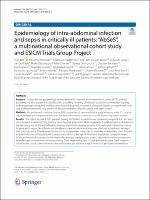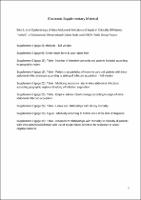| dc.contributor | Vall d'Hebron Barcelona Hospital Campus |
| dc.contributor.author | Blot, Stijn |
| dc.contributor.author | Blot, Koen |
| dc.contributor.author | Creagh-Brown, Ben |
| dc.contributor.author | Rello Condomines, Jordi |
| dc.contributor.author | Antonelli, Massimo |
| dc.contributor.author | Arvaniti, Kostoula |
| dc.contributor.author | de Lange, Dylan |
| dc.date.accessioned | 2020-09-02T08:16:58Z |
| dc.date.available | 2020-09-02T08:16:58Z |
| dc.date.issued | 2019-10-29 |
| dc.identifier.citation | Blot S, Antonelli M, Arvaniti K, Blot K, Creagh-Brown B, de Lange D, et al. Epidemiology of intra-abdominal infection and sepsis in critically ill patients: “AbSeS”, a multinational observational cohort study and ESICM Trials Group Project. Intensive Care Med. 2019 Oct 29;45(12):1703–17. |
| dc.identifier.issn | 0342-4642 |
| dc.identifier.uri | https://hdl.handle.net/11351/5205 |
| dc.description | Intra-abdominal infection; Peritonitis; Sepsis |
| dc.description.abstract | Purpose: To describe the epidemiology of intra-abdominal infection in an international cohort of ICU patients according to a new system that classifies cases according to setting of infection acquisition (community-acquired, early onset hospital-acquired, and late-onset hospital-acquired), anatomical disruption (absent or present with localized or diffuse peritonitis), and severity of disease expression (infection, sepsis, and septic shock). Methods: We performed a multicenter (n = 309), observational, epidemiological study including adult ICU patients diagnosed with intra-abdominal infection. Risk factors for mortality were assessed by logistic regression analysis. Results: The cohort included 2621 patients. Setting of infection acquisition was community-acquired in 31.6%, early onset hospital-acquired in 25%, and late-onset hospital-acquired in 43.4% of patients. Overall prevalence of antimicrobial resistance was 26.3% and difficult-to-treat resistant Gram-negative bacteria 4.3%, with great variation according to geographic region. No difference in prevalence of antimicrobial resistance was observed according to setting of
infection acquisition. Overall mortality was 29.1%. Independent risk factors for mortality included late-onset hospitalacquired infection, diffuse peritonitis, sepsis, septic shock, older age, malnutrition, liver failure, congestive heart failure, antimicrobial resistance (either methicillin-resistant Staphylococcus aureus, vancomycin-resistant enterococci, extended-spectrum beta-lactamase-producing Gram-negative bacteria, or carbapenem-resistant Gram-negative bacteria) and source control failure evidenced by either the need for surgical revision or persistent inflammation. Conclusion: This multinational, heterogeneous cohort of ICU patients with intra-abdominal infection revealed that setting of infection acquisition, anatomical disruption, and severity of disease expression are disease-specific phenotypic characteristics associated with outcome, irrespective of the type of infection. Antimicrobial resistance is equally common in community-acquired as in hospital-acquired infection. |
| dc.language.iso | eng |
| dc.publisher | Springer Nature |
| dc.relation.ispartofseries | Intensive Care Medicine;45(12) |
| dc.rights | Attribution-NonCommercial 4.0 International |
| dc.rights.uri | http://creativecommons.org/licenses/by-nc/4.0/ |
| dc.source | Scientia |
| dc.subject | Raonament basat en casos |
| dc.subject | Septicèmia |
| dc.subject | Tracte gastrointestinal - Malalties |
| dc.subject.mesh | Intraabdominal Infections |
| dc.subject.mesh | Cohort Studies |
| dc.subject.mesh | Sepsis |
| dc.title | Epidemiology of intra-abdominal infection and sepsis in critically ill patients: “AbSeS”, a multinational observational cohort study and ESICM Trials Group Project |
| dc.type | info:eu-repo/semantics/article |
| dc.identifier.doi | 10.1007/s00134-019-05819-3 |
| dc.subject.decs | infecciones intraabdominales |
| dc.subject.decs | estudios de cohortes |
| dc.subject.decs | sepsis |
| dc.relation.publishversion | https://link.springer.com/article/10.1007%2Fs00134-019-05819-3 |
| dc.type.version | info:eu-repo/semantics/publishedVersion |
| dc.audience | Professionals |
| dc.contributor.authoraffiliation | [Blot S, Blot K] Department of Internal Medicine and Pediatrics, Ghent University, Campus UZ Gent, Ghent, Belgium. [Antonelli M] Department of Anesthesiology, Intensive Care and Emergency Medicine, Fondazione Policlinico Universitario A. Gemelli IRCCS, Rome, Italy. Università Cattolica del Sacro Cuore, Rome, Italy. [Arvaniti K] Intensive Care Unit, Papageorgiou University Affiliated Hospital, Thessaloníki, Greece. [Creagh-Brown, B] Surrey Perioperative Anaesthetic Critical Care Collaborative Research Group (SPACeR), Royal Surrey County Hospital, Guildford, UK. Department of Clinical and Experimental Medicine, University of Surrey, Guildford, UK. [de Lange D] Department of Intensive Care Medicine, University Medical Center Utrecht, University Utrecht, Utrecht, The Netherlands. [Rello J] Centro de investigación en red de enfermedades respiratorias (CIBERES), Madrid, Spain. Recerca clínica/Innovació en la pneumònia i sèpsia, Vall d’Hebron Institut de Recerca (VHIR), Barcelona, Spain |
| dc.identifier.pmid | 31664501 |
| dc.identifier.wos | 000493268200001 |
| dc.rights.accessrights | info:eu-repo/semantics/openAccess |


